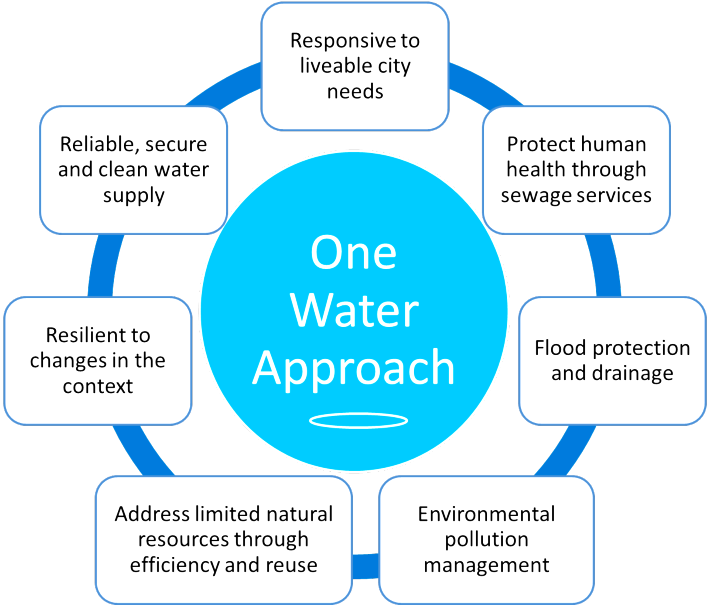One Water Approach | 14 Sep 2022
For Prelims: Grey Infrastructure, Green Infrastructure, Flood Protection, Aquifer Recharge, Integrated water resources management.
For Mains: One water Approach and why id needed.
Why in News?
The United Nations has estimated that by the year 2050, four billion people will be seriously affected by water shortages, pushing the One Water approach towards all sources of water.
What is the One Water approach?
- About:
- One Water Approach, also referred to as Integrated Water Resources Management (IWRM), is the recognition that all water has value, regardless of its source.
- It includes managing that source in an integrated, inclusive and sustainable manner by including the community, business leaders, industries, farmers, conservationists, policymakers, academics and others for ecological and economic benefits.
- It is an “integrated planning and implementation approach to managing finite water resources for long-term resilience and reliability meeting both community and ecosystem needs.
- One Water is the future of the water industry when the barriers conventionally separating wastewater, stormwater, drinking water, groundwater and the reuse and re-utilisation are broken down, many benefits realised.
- One Water Approach, also referred to as Integrated Water Resources Management (IWRM), is the recognition that all water has value, regardless of its source.
- Characteristics:
- All Water has Value: The mindset that all water has value — from the water resources in our ecosystems to our drinking water, wastewater and stormwater.
- A Multi-faceted Approach: Our water-related investments should provide economic, environmental, and societal returns.
- Utilising Watershed-Scale Thinking and Action: It should respect and respond to the natural ecosystem, geology, and hydrology of an area.
- Partnerships and Inclusion: Real progress and achievements will only be made when all stakeholders come forward and together will take a decision.
- Objectives:
Why is the One Water Approach Needed?
- Differences in regional water availability, pricing and affordability, the seasonal and inter-annual variation in supply, water quality and quantity, and unreliability of the resource poses great challenges.
- Aged infrastructure, supply-centric management, polluted waterbodies, agricultural and industrial expansion following changes in consumption and production patterns, a changing climate and disproportionate distribution of the water also push for new water techniques.
- At the global level, 31 countries are already facing a shortage of water and by 2025, there will be 48 countries facing serious water shortages.
- Recognising, measuring and expressing water’s worth and incorporating that into decision-making is still a challenge, apart from the water scarcity.
How is IWRM Superior to Conventional Water Management?
- In the conventional water management approach, drinking water, wastewater and stormwater are managed separately, whereas in ‘One Water’, all the water systems, regardless of its source, are connected intentionally and managed meticulously for water, energy and resources.
- Water is recycled and reused several times in IWRM, in contrast to a one-way route from supply to use, treatment and disposal.
- Stormwater is utilised as a valuable resource to fight against water scarcity, recharge groundwater and support natural vegetation.
- The water system includes green infrastructures and a mix of grey and green infrastructure that form a hybrid system as compared to grey infrastructure in conventional water management.
- Grey infrastructure refers to structures such as dams, seawalls, roads, pipes or water treatment plants.
- Green infrastructure refers to natural systems including forests, floodplains, wetlands and soils that provide additional benefits for human well-being, such as flood protection and climate regulation.
- Active collaborations with industry, agencies, policymakers, business leaders and various stakeholders is a regular practice in the ‘One Water’ approach, whereas collaboration is need-based in conventional water management systems.
Way Forward
- Failure to value water in all its forms is considered a prime cause of the mismanagement of water, according to the UN World Water Development Report 2021.
- Therefore, shifting the attention from a single-minded and linear water management to a multi-dimensional integrated water management approach, that is, the ‘One Water’ approach, for a comprehensive, resilient and sustainable management of water resources.
UPSC Civil Services Examination Previous Year Question (PYQ)
Prelims
Q. What are the benefits of implementing the ‘Integrated Watershed Development Programme’? (2014)
- Prevention of soil runoff
- Linking the country’s perennial rivers with seasonal rivers
- Rainwater harvesting and recharge of groundwater table
- Regeneration of natural vegetation
Select the correct answer using the code given below:
(a) 1 and 2 only
(b) 2, 3 and 4 only
(c) 1, 3 and 4 only
(d) 1, 2, 3 and 4
Ans: (c)
Exp:
- The Integrated Watershed Development Programme (IWDP) is implemented by the Department of Land Resources of Ministry of Rural Development.
- The main objective of IWDP is to restore ecological balance by harnessing, conserving and developing degraded natural resources such as soil, vegetative cover and water. Statements 1, 3 and 4 are describing ways to conserve and develop soil, water and vegetative crop and are included in IWDP.
- Watershed development refers to the conservation, regeneration and the judicious use of all the resources – natural (like land, water, plants, animals) and human – within the watershed area. Hence, 1, 3 and 4 are correct.
- However, the linking of the country’s perennial with seasonal rivers is not done under the watershed development programme. Hence, 2 is not correct.
- Therefore, option (c) is the correct answer.
Mains
Q. In what way micro-watershed development projects help in water conservation in drought-prone and semi-arid regions of India? (2016)

